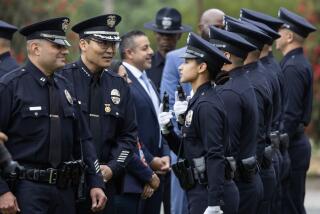Forging the Future of L.A.
There has never been a shortage of grand plans for Los Angeles.
In the 1920s, there was the sweeping drawing of a downtown civic center loosely resembling the mall in Washington, D.C. But it never made it off the page. In 1930, the “Olmsted” map of thousands of acres of parks from the coast to the desert was presented and rejected.
There also have been fanciful, but now defunct, transit proposals for an expanded freeway network, an assortment of trains and even a network of elevated walkways in downtown, to properly separate people and cars.
In a metropolis with a colorful history of shelved plans, questions about the city’s form have again surfaced as Los Angeles searches for a new chief for its Planning Department. Mayor James K. Hahn and planning activists are calling for the hiring of a “visionary” who can improve how the city looks, functions and flows.
“Obviously, what doesn’t work as well as anyone would like is that so many people live so far from work,” Hahn said. “I think we have a severe shortage of housing in the city, we have questions about where we’re going to build [more housing] while at the same time not destroying the character of single-family neighborhoods.”
On Thursday, about 100 community activists and planners gathered for a hearing to say what they expect from the next planning director: a leader who will reduce the impact of cars on the city, bring development to poorer neighborhoods, find room for more open space, use zoning laws to clear away nuisance businesses, attract inspired architecture and enforce better building-design standards.
And, not to be forgotten, build an effective transportation system and create more housing.
It will require “a rare individual,” said Ryan Snyder, a transportation planner, in an understatement.
Lofty hiring goals aside, the job of planning chief has long tilted more toward a bureaucrat to oversee the city agency that draws up zoning rules and doles out building permits.
Significant development decisions are made by the City Council while other city, county and regional agencies control key issues such as transportation and parks.
Yet the search has prompted repeated calls for a director who will be the urban planning equivalent of Los Angeles Police Chief William J. Bratton, outspoken and strong enough to stand up to a developer or neighborhood activist unwilling to do what’s best for the city.
“Los Angeles had defined itself by being able to imagine bigger and better and more fantastic things than anywhere else in the world,” says Councilman Eric Garcetti, citing the creative energy in a town that created, for instance, the motion-picture industry. “Yet in recent years we’ve retreated back to being a city of small ideas and small actions, and whenever anybody thinks of anything big, it immediately gets slapped down.”
Sprawling City
At nearly 470 square miles, L.A. is so massive that Boston, Chicago and the five boroughs of New York City could fit within the city’s boundaries -- with room left for a Solvang or two.
One irony of Los Angeles is that its original mass-transit system contributed to its sprawl. By the 1920s, L.A. was at the center of a 1,100-mile-plus network of trolley lines that allowed area residents to travel as far as Orange County.
The wildly popular new automobiles were faster, though, and helped kill the region’s transit system and encouraged further sprawl.
In the 1930s, city planners began envisioning a Los Angeles that would be different from most big cities, particularly New York. They embraced sprawl, which produced a horizontal rather than vertical city, heavily suburban, with more than one center and with cars as a fundamental way of getting around.
City Planning Director Calvin Hamilton helped formalize the vision in 1974. He delivered and the council approved a general zoning plan that encouraged high-density development around 38 centers in Los Angeles and an additional 18 outside the city. Transit was key to the plan.
“Each center had its own light-rail system that connected with the nearby areas, and the whole intent was not to have this tremendous development just in the downtown area, but to enable people to have jobs over practically the whole city, thereby reducing the commuting,” said Hamilton, now deceased, in a 1991 interview.
True to plan, buildings were erected in major centers -- Century City, Westwood, Warner Center in Woodland Hills. But the plan’s ambitious mass-transit system was not built. The size of L.A. and its many low-density neighborhoods have made it difficult to build big transit projects -- relatively few people live near stations and residents tend to protest new transit projects near their homes.
The Metropolitan Transit Authority, created in 1992, and its predecessor agencies have largely built a mass-transit system that emphasized buses. The $4.5-billion Red Line subway from Union Station to North Hollywood opened its final leg in 2000, after racking up huge budget overruns.
The cost prompted Los Angeles County Supervisor Zev Yaroslavsky to lead a successful 1998 ballot measure that prohibits spending of local sales-tax dollars on future subways.
A fledgling network of rail lines serves Los Angeles and the region today, carrying about 266,000 passengers daily. But it has not begun to match the scale mapped out in the centers’ plan offered in the 1970s. Throughout the region about 88% of all workers drive to their jobs, contrasted with 5% who use mass transit, according to the Southern California Assn. of Governments.
As traffic worsened in the 1980s, homeowner groups rose in discontent. Slow-growth, no-growth, not in my backyard became the mantras of the decade. The battle culminated in 1988, when city voters passed a ballot measure that reduced the size of future buildings.
One of the leaders of that effort was Laura Lake, now the president of Friends of Westwood, co-president of Save Westwood Village and among the most well known of the slow-growth advocates.
And she’s still fuming about the way L.A. planners allowed, in her opinion, Westwood to be overbuilt.
“There is something profoundly wrong with a city that knows it has problems and lets them get worse,” Lake says.
The Housing Factor
In 1900, the population of Los Angeles was about 102,000. By 1950 it had hit nearly 2 million and the number is expected to soon reach 4 million, according to new state estimates.
The city’s housing stock hasn’t kept pace and what houses there are, remain out of reach for many residents.
Median home prices in the city range from $200,000 to well over a million dollars, depending on the part of town, according to DataQuick Information Systems.
In the Los Angeles region, only 17% of households can afford to buy a median-priced home, and that’s assuming they have a 20% down payment, according to the California Assn. of Realtors.
Rents, too, remain expensive. The average one-bedroom apartment is approaching $1,200 per month, according to the USC Lusk Center for Real Estate.
“We have this suburban heritage and if people stopped coming here or having kids 30 years ago we’d be fine,” said Kevin Keller, chief planning deputy for Councilwoman Cindy Miscikowski. “But they haven’t, so it’s a question of where to put the growth that is coming.”
With little room to grow outward, the plan now calls for building upward in many of the city’s busy commercial corridors, such as Ventura Boulevard and in Hollywood.
But denser housing projects -- even those that revitalize streets -- tend to meet stiff neighborhood resistance, largely because few want more people disturbing their space.
Lincoln Boulevard, in Venice, is much like the city’s other large boulevards -- a mishmash of businesses, fast-food joints, strip malls and lube shops.
A Boston developer wants to replace an existing supermarket and other stores along Lincoln Boulevard with a new grocery store, other retail businesses, 280 housing units -- 56 reserved for low-income residents -- and 1,902 parking spaces. The project has been in the works for six years.
Last week, Echo Park residents vented complaints at City Hall over a 52-unit affordable housing project proposed for Temple Street. “Put them somewhere else. Spread them out. We don’t have the infrastructure,” Margarita Fernandez said after the meeting.
Later this month, Councilmen Ed Reyes and Garcetti are expected to unveil a proposed law that would require developers to make a certain percentage of new homes and apartments affordable to low- and medium-income residents.
The goal, which echoes the old centers’ plan, is not only to build more housing, but make it possible for the working class to live near their jobs in diverse parts of the city. Reyes and Garcetti acknowledge their idea will be controversial because it requires that low-income and affluent residents live side by side, a novel concept in many parts of L.A.
Reyes, chairman of the council’s influential planning committee, recognizes that the city has become a tough place for the working class. For too long, he says, few resources have been spent on planning and improving the infrastructure in poorer areas, making it unattractive to developers.
“Developers have scouts who go into areas around the city where they’re looking to invest,” Reyes added. “But when they go down Central Avenue or Broadway or all these major streets in South or East L.A., it’s impossible for them to see how you can even suggest a residential development on a street where all you see is a motel, a liquor store, an abandoned store, a garage and all these junked cars piled up.”
Serious candidates
After being criticized by urban planners in town for leading a lackluster search, Hahn has twice extended the deadline for applicants.
So far, 30 have applied and about 13 are serious candidates, said Renata Simril, deputy mayor for economic development and housing. The May 20 deadline to apply could again be extended.
Given the interview process, the mayor, be it Hahn or Antonio Villaraigosa, is not expected to make a hire until later in the summer.
Although a mayoral appointment, the hire is subject to council approval. The new planning director will take over a city agency of about 270 workers, a $22.6-million budget and a backlog of 83 zoning plans waiting to be completed.
He or she will also inherit a city with a 6-year-old General Plan, which specifies what can be built and where.
But because developers frequently ask for exemptions from the zoning laws, decisions often fall to the City Council. “We know very, very well what we want L.A. to be within the structure that we have,” Miscikowski said. “We just do a really, really lousy job of articulating what that vision is.”
For all the problems and conflicts, though, many planners cite bright spots in the city.
Downtown has seen several thousand new residents move in, the result of a 1999 law to allow offices to be converted to lofts.
Disney Hall and the Cathedral of Our Lady of the Angels stand as architectural landmarks. Large, mixed-use buildings with retail and housing are being erected near subway and light-rail stations.
Con Howe, who has headed the Planning Department since 1992, bristles at the calls for a visionary to replace him. He says the existing zoning laws, if upheld, are already bringing about good development.
“In cities as vast as Los Angeles, long-range visions get implemented in a thousand incremental steps all heading in the same direction,” Howe said.
That optimism was often missing last week during the hearing at City Hall on the next planning director.
The complaints went on and on. Plans, such as the Olmsted park proposal, were eulogized.
As for the grand civic center mall plan, a picture of it hangs deep inside City Hall. Across Spring Street sits an empty lot, a parking lot and the dreary criminal courts building.
More to Read
Sign up for Essential California
The most important California stories and recommendations in your inbox every morning.
You may occasionally receive promotional content from the Los Angeles Times.










